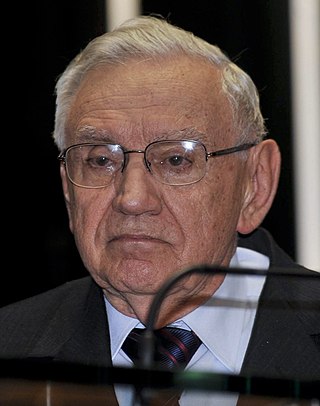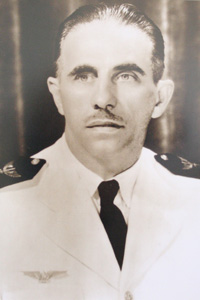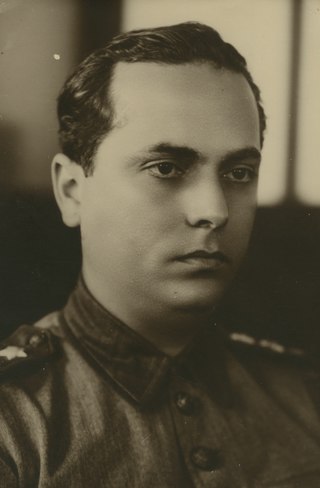
The Brazilian Air Force is the air branch of the Brazilian Armed Forces and one of the three national uniformed services. The FAB was formed when the Army and Navy air branches were merged into a single military force initially called "National Air Forces" in 1941. Both air branches transferred their equipments, installations and personnel to the new force.

Campo de Marte Airport is the first airport built in São Paulo, Brazil, opened in 1929. It is named after Champ de Mars, in Paris, which in turn got its name from Campus Martius, in Rome.

Air Marshal Eduardo Gomes was a Brazilian politician and military figure from Petrópolis.

The Brazilian Department of Science and Aerospace Technology is the national military research center for aviation and space flight. It is subordinated to the Brazilian Air Force (FAB).

Ozires Silva is a Brazilian entrepreneur who is the founder of Embraer.

The Caudron G.3 was a single-engined French sesquiplane built by Caudron, widely used in World War I as a reconnaissance aircraft and trainer.

Casimiro Montenegro Filho was a Brazilian army and air force officer. He reached the rank of Marechal-do-ar, the highest rank of the Brazilian Air Force rank system.

The Muniz M-7 was a two-seat primary training biplane with tandem open cockpit and powered by a 130 hp (197 kW) de Havilland Gipsy Major engine. Designed by Lieutenant-Colonel Antonio Muniz, a serving officer in the Brazilian Air Force, as a primary trainer. It was the first production aircraft designed in Brazil. The M-7 prototype was built at the Central Aeronautics Park and was first flown in October 1935. Production aircraft were built by Companhia Nacional de Navegação Aérea (CNNA) at Viana Island,. 11 aircraft were flown from 1937–1941 by the Military Aviation School based in Campo dos Afonsos, with the remaining 17 aircraft being sent to flying clubs.

Jacarepaguá–Roberto Marinho Airport is an airport in the neighborhood of Barra da Tijuca, Rio de Janeiro, Brazil dedicated to general aviation. Following extensive renovation in 2008 the airport was renamed after Roberto Pisani Marinho (1904–2003), a journalist and former president of Globo Network. It is a major helibase for offshore support.

Afonsos Air Force Base – BAAF is a base of the Brazilian Air Force, located in the district of Marechal Hermes, in Rio de Janeiro, Brazil.

The TAM Museum, also known as the Museu Asas de um Sonho, is an aviation museum in the city of São Carlos, within the state of State of São Paulo, Brazil. The museum was located 15 kilometers (9.3 mi) from central São Carlos, and 250 kilometers (160 mi) from São Paulo City.

The Brazilian Air Force Academy is the Brazilian Air Force's educational institution that provides initial officer training for the main Officer Board of Brazil's Air Force Command. The academy is located east of Pirassununga city, in São Paulo State county, and it is the largest Brazilian Air Base as well as the largest Air Force Academy of Latin America. All three Officer Formation Courses (CFOs) of Academia da Força Aérea are recognized as Superior Degree by Brazil's Ministry of Educations.
Manguinhos Airport was an airport that existed in the neighborhood of Manguinhos, near Oswaldo Cruz Foundation in Rio de Janeiro from 1936 to 1972.

Antônio Guedes Muniz was the pioneer of the Brazilian aviation industry.

Brazilian Army Aviation, created in 1919, operated fixed-wing aircraft (planes) as part of the Brazilian Army until its incorporation into the Brazilian Air Force in 1941, when it ceased to exist. The Brazilian Army returned to having an air component in 1986, with the same name and history, but using rotary-wing aircraft (helicopters) instead. From 1927 to 1941, aviation became the fifth branch of the army, alongside infantry, cavalry, artillery and engineering. Its staff were trained at the Military Aviation School, founded in 1919 in Campo dos Afonsos, Rio de Janeiro, and remembered as a precursor to the current Army Aviation Instruction Center and Air Force Academy.



























